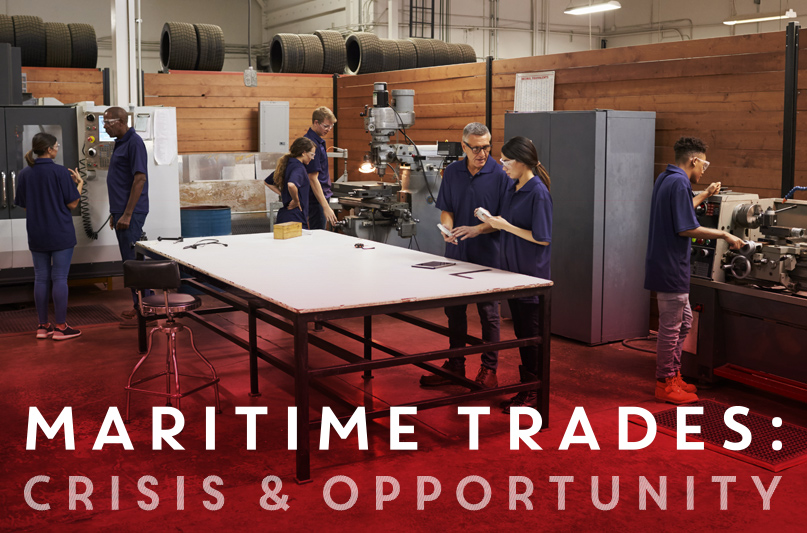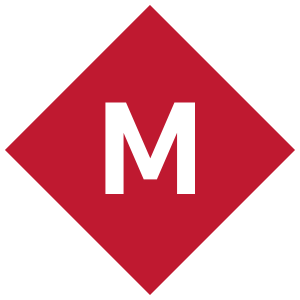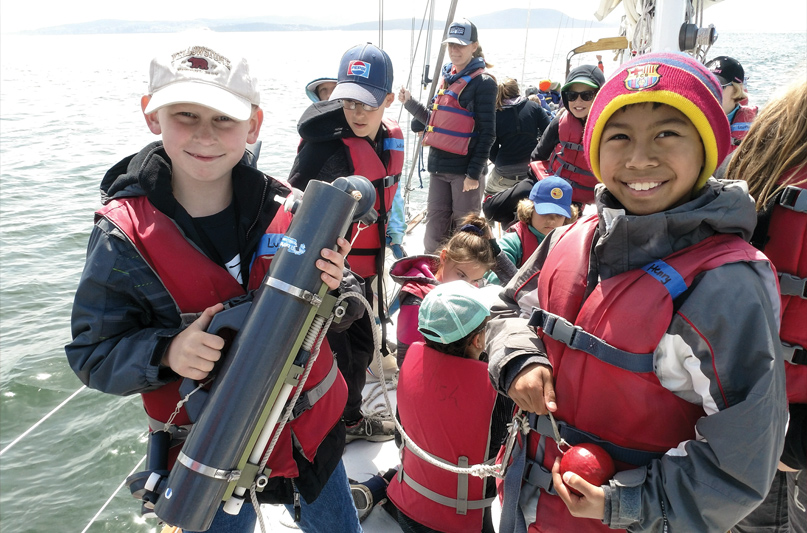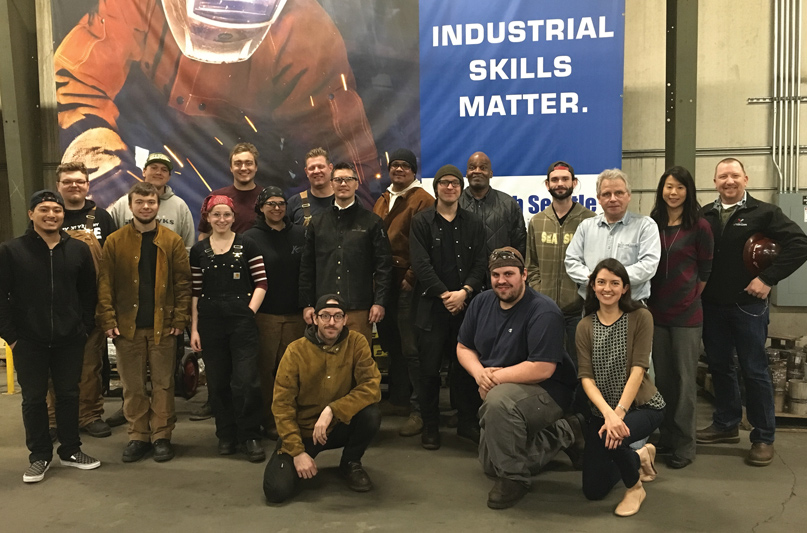
 Malcolm Dunston’s handshake is a bone crusher. This strapping 19-year-old works full-time at CSR Marine Services in Ballard and has climbed the ranks of this boatyard since he was hired the same day he turned 18.
Malcolm Dunston’s handshake is a bone crusher. This strapping 19-year-old works full-time at CSR Marine Services in Ballard and has climbed the ranks of this boatyard since he was hired the same day he turned 18.
“Last year, I started out and I was cleaning boats and taking out the trash. Now I am a professional bottom painter,” says Dunston. Proudly wearing his CSR white (okay, white with dirt and stray paint) coverall uniform with his name emblazoned on it, he sits down with me to talk about his background, his current position, and his long-term plans.
“Some of my friends are in jail for murder and some are in college playing sports. I wasn’t sure where I was going to go after high school, but the CSR job means that I have a way to build upon something that I love to do, which is to work with my hands and to make a lot of money doing it,” he says.
His supervisor, Scott Anderson, who co-owns CSR, chimes in periodically during the interview to remind me of his biggest need. “I can’t find workers. If someone could just show up here and fog up a mirror, they would be hired. Malcolm’s great, but there aren’t enough Malcolms.”

Anderson’s experience is that neither the quality nor the quantity of marine trades workers exist. While he strongly supports training younger workers, he has grown increasingly frustrated at how hard it is find and maintain a staff. “I love career and technical education like Core Plus (which Dunston participated in), but it’s a complex topic with many problems that need addressing for our industry to find the next generation of employees. Get this, can you believe that the state doesn’t even fund the development of a maritime curriculum to teach the trades?”
The U.S. has reached a 50-year low in raw unemployment numbers with a jobless rate of 3.7 percent in September (though the economy added a less-than-expected 134,000 jobs, according to the Bureau of Labor Statistics). Washington has a 4.6 percent unemployment rate. Additionally, the number of people going into hands-on technical positions has declined. According to a national study from the Association of General Contractors, there will be a shortage of 31 million tradespeople by 2020.
“The college-for-all mantra gets beat into kids’ and parents’ heads. The simple fact is that college may not be for everybody,” said Rep. Gael Tarleton, a Democrat representing the Ballard area and environs, who successfully passed legislation to make career and technical education a component of basic education for the state. Folding Career Technical Education into basic education means that the state is obligated to fully fund these two per Washington’s Constitution.
Dunston exemplifies how college may not be the next logical step for all kids out of high school. Tory Gering of Core Plus, one of the premier CTE programs for the state, worked with Dunston to prepare him for his CSR career. “Malcolm wasn’t super interested in college. Core Plus helped him graduate by providing math and science credit at Rainier Beach High School. He was 17 at the time when he graduated from Rainer. He started fulltime on his 18th birthday, bussing two-hours each way from Rainier Beach to Ballard and he’s never looked back,” said Gering.
With baby boomers (that generation born between 1946 and 1964) retiring in ever-growing numbers, the labor shortage is becoming more acute. Boomers began leaving the workforce in 2011 and now about 10,000 retire each day, taking vast institutional knowledge with them. An infographic released by staffing company Adecco asserts that 53 percent of skilled trade workers have reached age 45, while nearly 19 percent are over 55. Workers are aging, and not enough young people have an interest in stepping into those roles. If they do, they often lack the skills necessary for them.
Ann Avary, a maritime leader who specializes in training the next generation of workers and runs the Northwest Center of Excellence for Marine Manufacturing & Technology, hears about the demand every day. “A day doesn’t go by that I don’t get three calls from employers looking for employees,” she said. The Center of Excellence serves as a statewide liaison to business, industry, labor, and education with a purpose to create a highly skilled and readily available workforce that is critical to the success of the industries that drive the state’s economy. While it’s filling a need, the Center can’t keep up with demand, according to Avary.
“Automation and technological improvements will have a transformational impact on skills, education, and training. Right now, the industry needs technical talent in nearly every area, shore side, underway, seafood processing, logistics, aluminum welding, electrical, systems, engineering, operations, mechanical, crane operators, electronics, refrigeration systems, the list goes on,” said Avary.
She continued, “As educators, we have to be willing and able to step up to the challenge of supporting a workforce for the industry. That means taking a more entrepreneurial approach to how we educate, train, and provide professional development: supporting a registered apprenticeship and pre-apprenticeship model that works for small and medium sized employers, more effective outreach to underserved and underrepresented communities, and placing a focus on the technical competencies and skills our employers are telling us they need while ensuring programs are reflective of that. We’re doing a lot of work with women, tribal, and latino/latina communities right now, with more work coming in other communities.”
These issues are not limited to the Northwest. Bill Yeargin of Correct Craft boats prescribed some solutions to address the shortage of workers nationally in a wildly-circulated column he recently wrote. As Yeargin sees it, first the economy and businesses need people who will show up and work hard even if they don’t have the training. Second, the industry needs people who have technical skills. Yeargin also offers some solutions:
- Promote our industry as a great place to work, similar to how we promote boating as a great way to invest time with friends and family.
- Establish relationships with trade schools all over the country to ensure the students know about the boating industry and the opportunities we offer.
- Use our existing boat shows to promote careers in boating. This is a unique tool we have in our industry that can help introduce boating careers to those who attend.
- Consider the acquisition of a trade school to be owned by the National Marine Manufacturers Association.
Each of Yeargin’s points has a direct tie to momentum in Washington. When it comes to promoting the industry as a great place to work, the Washington Maritime Federation, the state association that represents the maritime industry, is putting together a plan to recruit more young people in the trades. Plus, examples of new leadership at established programs at the Seattle Maritime Academy and the Northwest School of Wooden Boatbuilding serve as platforms to learn about career options for those seeking land and sea employment opportunities.
Avary recognized how the word needs to get out about the pay, especially considering how much debt students typically carry. “Money gets a little sticky. The industry has outstanding career opportunities. The average annual salary for underway is about $70,000 and for shoreside it runs around $56,000. There is quite a bit of variance, depending on experience, skill, and location.”

According to a Seattle Times story from 2017, the state university with the highest average debt per student is Washington State University (WSU) at $25,874. About 58 percent of WSU grads had student debt. University of Washington Seattle students carried an average debt load of $21,900.
When it comes to establishing relationships with trade schools, Gering, with Core Plus, recently wrapped up a visit to Colville, Washington. Gering spends a lot of time meeting with shop teachers, and this year received the award for the Outstanding Business Champion, which was awarded by the State Shop Teacher Association.
“From Colville to the Puget Sound Naval Shipyard, companies are starting to seek partnerships with their local high schools. And thanks to programs like Core Plus, they get connected with dynamic teachers and get results in a short amount of time,” she said. “There’s somewhere around 400 shop classes in Washington high schools, although no one would guess it. It’s difficult to compete with the college-for-all movement, but it’s starting to happen with good success. I think some of these start-up, short-term, feel-good government initiatives could learn a lot from what’s already being done within the K-12 schools.”
The Northwest Marine Trade Association sponsors a career fair each year at the Seattle Boat Show. Twenty-three exhibitors attended last year seeking to fill about 350 positions. Attendees from the career fair then received complimentary admission to the show. Last year, 125 job-hunters attended and several were hired on site. “I wouldn’t miss it,” said Scott Anderson. “That job fair is reminder that these openings can change lives and feed families.”
The acquisition of a trade school is a topic that leaders, including a newly elected port commissioner, are prioritizing. The desire would be to build on the success of the aerospace high school in Renton. Avary of the Center of Excellence for Marine Manufacturing provides a global perspective to addressing the skills gap.

“We (the maritime industry) are definitely not out of the woods. The industry is competing with itself and other industries for a scarce technical talent pool,” she said. “Technology will drive change for many, if not most of the jobs in the industry and in all sectors of the industry: digital switching, robotics, artificial intelligence, and autonomous systems are here now, and these systems will become more sophisticated and adopted going forward.”
While technology may make jobs more efficient, the need for Malcolm Dunston and his peers to grab hold of these positions, in the meantime, will not go away. “My biggest accomplishments are learning how to lay fiberglass and to learn new things every day. Every day is different and every day I learn something new. And I have big plans. Next on my list is to get certified in underwater welding. I didn’t even know that was a thing just a few years ago,” says Dunston.
So next time you get frustrated by the lengthy period of time it takes before your boat is put back in the water and ready for your trip, keep in mind that there’s simply not enough people to work on your boat and that disparity is not for lack of coordination. There’s a lot to the story that keeps your boat in the repair yard longer than you’d like. Fortunately, Duston and others are on the case. “I’m in this for the long haul,” he says as he dashes back to the yard.


